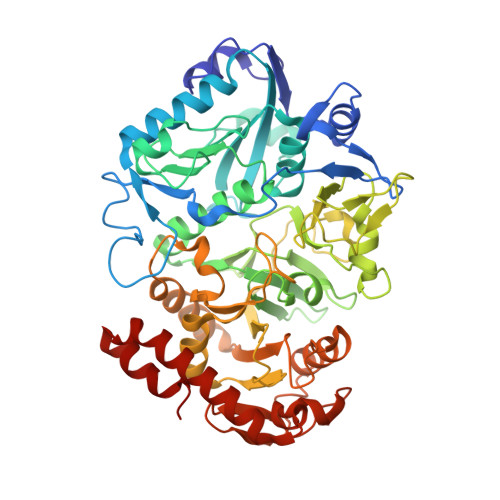Mechanisms of activation of phosphoenolpyruvate carboxykinase from Escherichia coli by Ca2+ and of desensitization by trypsin.
Sudom, A., Walters, R., Pastushok, L., Goldie, D., Prasad, L., Delbaere, L.T., Goldie, H.(2003) J Bacteriol 185: 4233-4242
- PubMed: 12837799
- DOI: https://doi.org/10.1128/JB.185.14.4233-4242.2003
- Primary Citation of Related Structures:
1OS1 - PubMed Abstract:
The 1.8-A resolution structure of the ATP-Mg(2+)-Ca(2+)-pyruvate quinary complex of Escherichia coli phosphoenolpyruvate carboxykinase (PCK) is isomorphous to the published complex ATP-Mg(2+)-Mn(2+)-pyruvate-PCK, except for the Ca(2+) and Mn(2+) binding sites. Ca(2+) was formerly implicated as a possible allosteric regulator of PCK, binding at the active site and at a surface activating site (Glu508 and Glu511). This report found that Ca(2+) bound only at the active site, indicating that there is likely no surface allosteric site. (45)Ca(2+) bound to PCK with a K(d) of 85 micro M and n of 0.92. Glu508Gln Glu511Gln mutant PCK had normal activation by Ca(2+). Separate roles of Mg(2+), which binds the nucleotide, and Ca(2+), which bridges the nucleotide and the anionic substrate, are implied, and the catalytic mechanism of PCK is better explained by studies of the Ca(2+)-bound structure. Partial trypsin digestion abolishes Ca(2+) activation (desensitizes PCK). N-terminal sequencing identified sensitive sites, i.e., Arg2 and Arg396. Arg2Ser, Arg396Ser, and Arg2Ser Arg396Ser (double mutant) PCKs altered the kinetics of desensitization. C-terminal residues 397 to 540 were removed by trypsin when wild-type PCK was completely desensitized. Phe409 and Phe413 interact with residues in the Ca(2+) binding site, probably stabilizing the C terminus. Phe409Ala, DeltaPhe409, Phe413Ala, Delta397-521 (deletion of residues 397 to 521), Arg396(TAA) (stop codon), and Asp269Glu (Ca(2+) site) mutations failed to desensitize PCK and, with the exception of Phe409Ala, appeared to have defects in the synthesis or assembly of PCK, suggesting that the structure of the C-terminal domain is important in these processes.
- Department of Biochemistry, University of Saskatchewan, Saskatoon, Saskatchewan, Canada S7N 5E5.
Organizational Affiliation:




















